In the first year, the child develops at a very fast pace. New skills appear literally every day, and very often kids "give out" a whole range of innovations at once, making a real leap. Especially indicative in this regard is the third month of the baby's life.

The development of a child in 3 months is the result of all that the baby has learned over the past time. After the adaptation to new conditions and the mode of existence has ended, the child begins to actively study the world. His physical, mental, emotional and social development is entering an active phase.
We can distinguish the main "achievements" that a child demonstrates at 3 months:
- Due to the intensive development of subcutaneous adipose tissue, a 3-month-old baby “rounds up”: his body becomes chubby, cheeks and folds-dressings appear on the limbs.
- In physical terms, the baby acquires new skills. By 3 months, children master a coup from the back to the tummy, and lying on their stomach, they can rise for several minutes, resting on their forearms.
- A semblance of the regime of the day begins to emerge: the child begins to sleep and stay awake at about the same hours, so it becomes easier for mom to plan her day. DETAILS about a 3-month baby’s day.
- The period begins when the baby tries everything on the tooth.
Well, now let's talk in more detail about the development of the child in all areas.
Height and weight
The physical development of the child is always very worrying for both parents and pediatricians. Monthly visits to the clinic are accompanied not only by a general examination, but also by measuring weight and height. In general, an indicator of the rate of growth and weight is very conditional. For a child of 3 months, you can roughly focus on the following numbers:
- Weight 3-6 kg.
- Height 54-64 cm.
Different factors influence height and weight: birth weight and height, type of nutrition, genetics. The tables used by most pediatricians were developed by Soviet specialists and compiled on the basis of data on children receiving an artificial mixture.

Currently, many mothers are exclusively focused on breastfeeding, so the baby’s parameters may differ from the table numbers. For a pediatrician, this may be an occasion to talk about underweight or excess body weight, but if you are breastfeeding, remember that the increase in HB can be from 0.5 to 2 kg. It is simply impossible to overfeed a child with breast milk, it is possible to underfeed only if the feeding technique is violated (how to breastfeed)For example, if the mother does not allow the baby to be at the breast for as long as it requires, or often changes the breast.
Mothers of babies should be more calm about mismatches in the height and weight of the child with certain numbers. If the child is active, eats well, sleeps, actively studies the world around him, if he writes at least 12 times a day and poops 6-8 times, his hair and nails grow - it means that he is in perfect order.
Three month reflexes
The baby’s behavior and actions are regulated by reflexes and instincts. Most newborn reflexes are already dying away by 3 months. So, for example, at this age, the presence of the following reflexes may indicate a neurological pathology:
- search reflex (in response to stroking the corner of the lips, the child turns the head toward the stimulus and opens his mouth);
- proboscis reflex (touching the upper lip leads to the fact that the child extends his lips in the form of a proboscis);
- Babkin’s reflex (when pressing a finger on a baby’s palm, he opens his mouth and moves his head forward).
Some reflexes may still persist. For example, Moro’s reflex, expressed in the fact that the child throws up his hands and spreads his fingers when he is laid on his back or his legs are lifted above the surface. This ancient reflex is evolutionarily designed to protect a child from falling.
But the sucking reflex and the crawl reflex at 3 months are still very pronounced, since they are directly involved in the survival and harmonious development of the child.
We also read: baby reflexes
New skills
Basic skills that are formed by 3 months:
- the ability to roll over from the back to the barrel;
- the ability to raise the head and shoulders with support on the forearm;
- holds the head and controls it;
- recognizes the faces of mom and dad;
- laughs when talking;
- naughty and whimpering;
- grabs a toy and pulls it into his mouth;
- walks, cooes;
- gets his hands on toys hanging over the crib;
- rests with legs on a hard surface with support under the armpits.
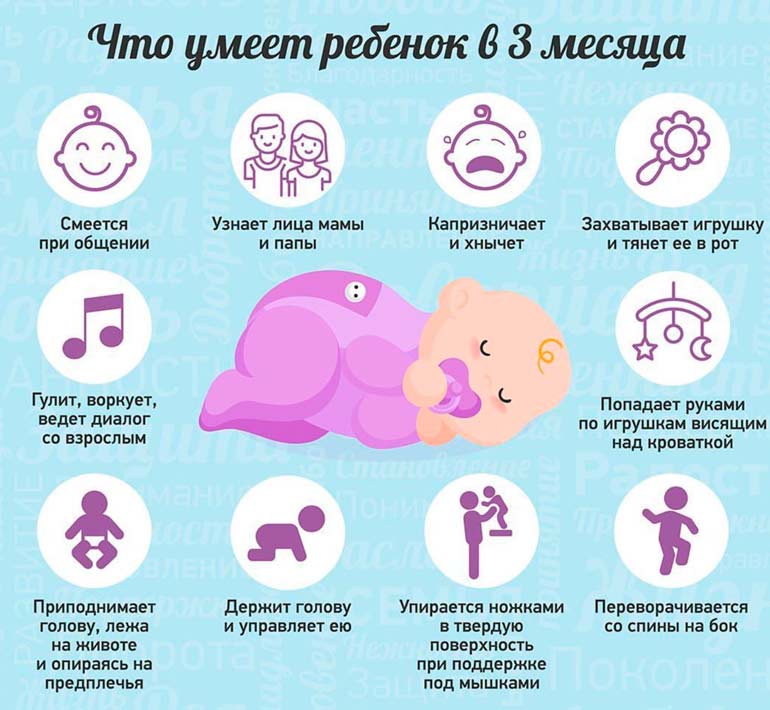
There are no strict standards in this matter either. Some of the babies perform all these actions already in three months, someone begins to make their first attempts only closer to 4-5 months. Each little man has his own speed of development, so if the baby is healthy and does not have any neurological problems, he must learn to roll over and up (when the kids start rolling over).
By the way, the process of mastering new skills can be slightly accelerated. The following tips will help parents with this:
- To the standard daily gymnastics, add an exercise that stimulates upheavals. The baby lies on the back, his right leg needs to be lifted, holding the shin, and lead to the left, as if throwing it through the body. This moment in the upheaval is the most difficult for the child, because it is he who gives the whole body an impulse to make movement. Later, children learn to push themselves from a horizontal surface.
- Conscientiously carry out the entire range of exercises recommended by pediatricians. All new physical skills are based on the overall good development of the baby’s body and muscles.
- You can contribute to the development of the second skill in a very simple way: regularly lay the child on his stomach. And to lie in such a pose was interesting, lay bright toys in front of him. A great option for this age is a developmental mat. On it, the baby will not be bored either on his back or on his tummy. Many rugs have a small round mirror in the kit. Examining your reflection there while lying on your stomach is a fascinating activity.
Detailed article:What can a child do at 3 months
Another safety tip: after the baby has learned to roll over, do not leave it alone on high surfaces (on a sofa or changing table). The baby may fall and be injured. If you need to leave the room - transfer the baby to a crib or deck chair.
We also read: How to teach a child to roll over
The development of the psyche and emotional sphere (mental development in three months)
Mental and emotional development by 3 months is also gaining momentum. First of all, the sensory organs and basic mental functions are very actively developing.
Vision
Vision has changed significantly. Now the child knows how to follow the eyes of a moving toy, is able to peer into an object. This means that the child develops objective perception: he begins to perceive the subject as a set of properties, and the more sensory organs he can perceive the subject, the more information he will receive about the subject of observation. That is why kids are so fond of not only viewing, but also trying to bite or lick everything that falls into the pen.
Hearing
The child’s hearing is also developing and improving. At the age of 3 months, the baby already perfectly isolates different sounds from the general background, can accurately determine the source of the sound, and, of course, already knows native voices very well. On mother’s voice, the baby turns his head in her direction and smiles.
Feeling and perception for a child of 3 months are the main mental processes due to which there is a study of the world. These two processes occur in all areas of the senses: vision, hearing, smell, touch. The kid really likes to touch different surfaces and objects with his fingers, lick rattles, look at pictures and faces of people, enjoy different sounds.
Great progress has been observed in the emotional sphere. At 3 months, children begin to give their first conscious smiles, the most sincere and open. The main innovation of this age is the “revitalization complex” - a vivid emotional reaction that a child demonstrates when a close adult appears. The “revitalization complex” is manifested not only in smiles. The kid begins to actively walk, move his arms and legs, by all means showing how glad he is to see his own person.
Food and sleep
As we already said, by the age of three months the daily regime begins to take shape. This mode will still change several times, but for my mother there is already some certainty and the ability to plan her affairs. Basically, the baby, like a newborn, spends time eating and sleeping, but periods of active wakefulness already appear. The main questions in this regard: how much does a three-month-old baby eat and how much sleep?
Sleep, as before, takes up most of the day. At this age, children sleep in the amount of up to 17 hours. Usually, 9-10 hours of them fall at night, and the rest are allocated to 4 daytime sleeps.
You can say a lot about food, but we will focus on the main points.
If the baby’s nutrition is a bottle mixture, then the regimen and amount of feeding is determined by the recommendations of the producers of the adapted mixture. Babies who are breastfed suck their breasts on demand and are at their breasts for as long as they need.
For mothers who are breastfeeding, it will be useful to know that 3 months is the time of a growth spurt and a lactational crisis. This is a kind of turning point, which is very important to pass successfully.
We also read: All About Breastfeeding
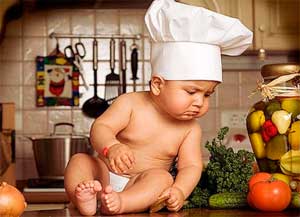 The child is actively exploring the world, so it may be difficult to attach to the chest. Many mothers say that the child begins to spin, look around to consider everything around, distracting from the chest.
The child is actively exploring the world, so it may be difficult to attach to the chest. Many mothers say that the child begins to spin, look around to consider everything around, distracting from the chest.
Not knowing about such features, the baby's restless behavior at the chest and the absence of hot flashes may be interpreted by the mother as a lack of milk and start feeding with the mixture. Do not do this. In the most critical period, which lasts only a couple of days, it is better to focus on the baby and constantly offer breasts, putting aside all household and personal affairs - this will help maintain lactation and successfully overcome a difficult moment.
Old-school pediatricians and loving grandmothers often begin to insist on the introduction of complementary foods at 3 months of age. Usually we are talking about apple juice, and then mashed potatoes. For breast-fed babies, these recommendations are no longer relevant.
We also read: When to introduce the first lure
What to do with baby: games with a child
In moments of active wakefulness, the baby is no longer interested in just lying in the crib. An inquisitive little pean seeks to see and hear something new and interesting.
Games at this age are quite simple and short. It’s great if the game is accompanied by a funny nursery rhyme or just a poem. The fact is that at 3 months speech is already beginning to develop. The child makes the first sounds, which in a scientific language are called pre-speech vocalizations. These are lingering vowels: oooh, aaaa, uhhh. For the full development of speech, you just need to hear words and sounds. Folklore works are suitable for babies as well as possible, because they were specially composed by our ancestors and are always chanted.
As part of the game, you can do finger gymnastics, massage the palms and feet, or invite the baby to touch different textures (pieces of fabric, cereals, etc.) with his pen. Rattle games are also a great option for 3 months.
You can invite the child to consider large pictures in a book, always saying and naming all objects and details. Pictures themselves for this age should be very sketchy and simple.
Communication with the child is important not only during games. In conversations with the baby, it is necessary to accompany every contact with him, whether dressing for a walk or changing a diaper. Speech should be emotional and calm. For a child, this is not only a way of development, but also an indicator of mother’s love and acceptance, and this is even more important than new information and skills.
Video: What to do with a 3 month old baby
Mom needs half an hour to spare. How to entertain a child at this time with the benefit of his development? And do you have time to cook dinner?
The third month of life. Child Development Calendar
A full calendar of the development of the child in one article “development up to a year by months” -https://kid.htgetrid.com/en/razvitie-rebenka-do-goda/razvitie-rebenka-do-goda-po-mesyatsam.html



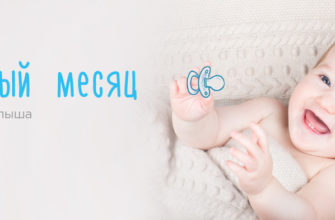


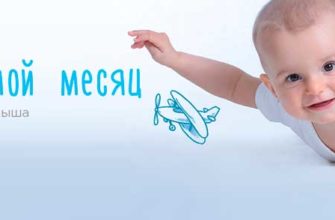
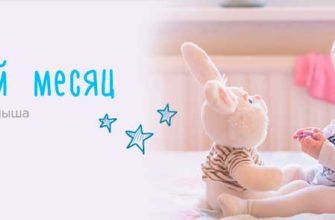
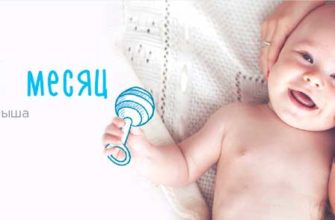
Very detailed and useful calendar. Thank.
I agree with Victoria. Breastfeeding is possible. And gaining more than a kilogram is not normal!
I myself know what I'm talking about. For the first month I fed over one and a half cologram. The child was always restless, did not sleep, shouted, was covered with a rash, the child always vomited. As soon as they switched to food according to the regimen, they began to type normally, the stomach stopped hurting, to vomit, the rash disappeared, and sleep improved.
Thank you very much for the article!
We still read bedtime stories to our child, or if we ourselves can’t do it, turn on the audio tale on the channel in the telegram @fairytaledaily that my friend advised me. They say that if children read fairy tales at night, they start talking much earlier and study much better at school)